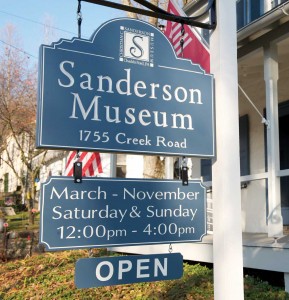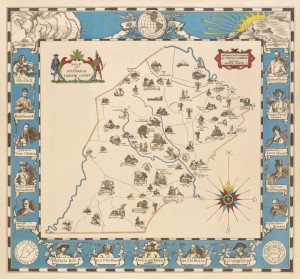Gem of a museum holds open house, opens door to another era in Unionville
By Mike McGann, Editor, UnionvilleTimes.com

Sitting quietly, near the legendary Hank's Place, on Creek Road, the Christian C. Sanderson Museum might be the region's best-kept secret.
CHADDS FORD — It is more than a history of a life, but really the history of the entire region, packed into a small gray and white house.
Tuesday night at The Christian C. Sanderson Museum, during the museum’s open house, it seemed like one person after another expressed shock at the amount and type of materials in the museum. “I’ve driven past this place thousands of times, but never imagined…”
That, of course, was the point of the event.
There are thousands of amazing and fascinating items on display, ranging from books owned and signed by Benjamin Franklin to one item after another that open a window into local life in the first half of the 20th century. Hours of browsing and study are just enough to scratch the surface. Thousands more documents and items aren’t on display, but available for research.
What so many folks never imagined, driving past the museum on Creek Road, is how woven into the fabric of life Chris Sanderson was for nearly three quarters of a century, not just in Chadds Ford, but Birmingham, Pocopson, Pennsbury and West Chester.
Sanderson was a teacher and a principal, working in many of the local one-room school houses common until today’s more modern school districts came into being. He taught at Chadds Ford, Locust Grove, Dilworthtown and Brinton’s Bridge among others. He was well-known for his fiddle playing and he and The Pocopson Valley Boys were the first name in square dancing in the area, even releasing a record in the 1950s of their most popular music.
An amateur historian and, to be honest, something of pack rat, Sanderson kept almost everything from his busy life, finally opening a makeshift museum in the months before he died in 1966. He attended virtually every important event along the eastern seaboard, including every presidential inauguration between 1904 and 1964. Living for a length of time in the house that served as Washington’s Headquarters during the Battle of Brandywine, which burned down in 1931, Sanderson and his widowed mother conducted public tours of the house. Sanderson was a noted lecturer and was a regularly-heard voice on WCOJ radio.
All of which would be fascinating enough by itself. Add one word, Wyeth, and the whole package is irresistible.
Sanderson had a close friendship with his Chadds Ford’s neighbor, N.C. Wyeth. Sanderson’s life became intertwined with that of the Wyeths, and he watched both Andrew and Jamie grow up. Works by the Wyeths — including a haunting 1937 portrait of Sanderson by Andrew Wyeth — can be found throughout the building. Andrew Wyeth led the effort to turn Sanderson’s chaotic collection into a real museum in the months and years after his death and today’s museum bears testament to that effort.
Beyond the artworks of the Wyeths — and there’s no shortage of that — there are dozens of smaller insights into their everyday lives, reminders that in addition to being American art icons, they were still largely normal people.
And even that is just the tip of the iceberg. The Sanderson Museum is open Saturdays and Sundays from noon to 4 p.m., March to November. Private tours can also be arranged by calling (610) 388-6545 or emailing info@sandersonmuseum.org.








Thanks for a great piece on this gem of a museum. This is THE place to take visitors. No matter what they’ve seen, they’ve never seen anything like it.
In addition to Andrew Wyeth, there were many others involved in the creation of the Sanderson. In my mind, the founding and now curator emeritus, Tom Thompson, is the most important person in creating, organizing and setting the themes of each room as well as writing the wonderful biography about him called “Chris”. Without Tom’s lifetime effort on the Sanderson Museum, “A Man’s Life, A Nation’s History” would not exist for all of us to enjoy. To my extreme pleasure and appreciation, Tom, in his 90’s, still works on items about the museum and produces wonderful reports on Chris and the areas he touched. Thank you, Tom.
Chuck Ulmann
Curator
Sanderson Museum
Chuck,
Thanks for adding that…I wasn’t aware of that, and I appreciate you setting the record straight.
I haven’t been there in many years, but it really is a wonderfully quirky and interesting little museum, and so easily overlooked. Thanks for the story.